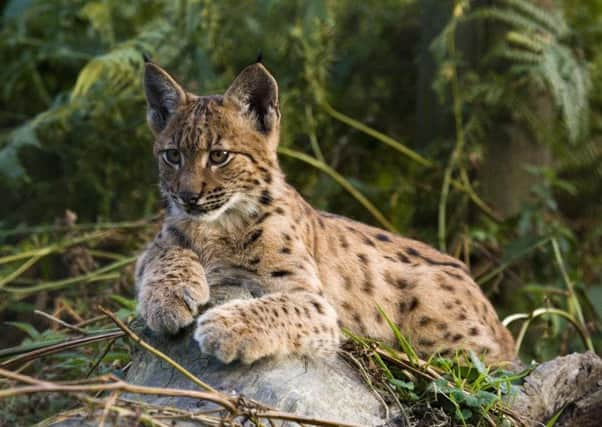Wild lynx set to be reintroduced to Highlands in 2016


Landowners, farmers, gamekeepers and conservation groups are being asked to give their thoughts on reintroducing the once-native lynx to parts of Scotland and England.
Conservationists claim bringing back the deer-killing cats could offer huge benefits for the economy as well as the environment. They maintain the distinctive-looking predators pose no danger to people and are “little to no threat for pets or livestock”, but could generate millions of pounds in eco-tourism opportunities and control of exploding deer populations.
Advertisement
Hide AdAdvertisement
Hide AdThe Lynx UK Trust has suggested trial reintroductions in Aberdeenshire, Argyll, Northumberland, Cumbria and Norfolk over a five-year period.
Other organisations have previously suggested lynx could play an important role in “rewilding” parts of the UK, including the Scottish Wildlife Trust, Trees for Life and Rewilding Britain.
The Cairngorms National Park Authority has also examined the effects of bringing back the short-tailed cats, as well as bears and wolves. Of the three top predators, lynx were considered to have the least negative impact on farmers.
But the National Farmers Union (NFU) Scotland has major concerns over the plans.
Government nature agency Scottish Natural Heritage has also said reintroduction schemes are “complex” and require “considerable planning” to meet UK and international guidelines.
But the trust insists the plan has widespread backing and could generate millions of pounds from eco-tourism. Up to 91 per cent of people who responded to a poll carried out by the charity earlier this year said they support the move, which is aimed at balancing out deer overpopulation and its damaging effects on forestry and agricultural crops.
A report for the charity by consultancy firm AECOM looks at the impacts of reintroducing the Eurasian lynx at two proposed sites - Kielder Forest in Northumberland and Thetford Forest on the border of Norfolk and Suffolk.
The findings show bringing back the lynx would generate £65.7 million from eco-tourism, creating rural jobs, while also improving crop yields and woodland management by keeping down deer.
Advertisement
Hide AdAdvertisement
Hide AdThe plan would cost £1.4 million over 25 years for the two sites, but would deliver £47 of benefits for every £1 spent.
“Our cost-benefit analysis shows that the argument for reintroducing lynx to the UK is compelling from an economic, social and environmental perspective,” said Chris White, senior environmental economist at AECOM.
“At a time when the UK needs to think laterally and creatively to realise economic benefits, this is an idea that should be fully explored, especially for the potential eco-tourism and job opportunities in rural communities.”
Dr Paul O’Donoghue, chief scientist for Lynx UK Trust, said: “This consultation document, and the research it quotes, makes an overwhelmingly strong case for reintroduction of these amazing cats; they fit into the modern UK environment beautifully and can deliver a huge range of benefits for all of us, but of course we have to get the process right; this is a unique and ever-evolving project and we really want to get stakeholders involved in helping to shape it.”
But Andrew Bauer, deputy director of policy for NFU Scotland, said: “Whilst the prospect of lynx reintroduction has left some breathless with excitement, there are good reasons why the farming community is more wary.
“In some parts of Europe the impact of lynx is moderate – very distressing and damaging for those who lose lambs, but not a widespread problem.
“There are other parts of Europe where the impact is far greater – with official reports concluding that tens of thousands of lambs are being predated each year in Norway alone by species such as lynx and wolves.
“Farmers are quite right to question why and how lynx, absent from Scotland since medieval times, should be reintroduced.
Advertisement
Hide AdAdvertisement
Hide Ad“Alongside trumpeting the benefits, those who advocate lynx reintroduction should be up front about the potential impacts on Scotland’s hugely important sheep farming industry and the potentially very significant cost to the public purse.
“Anyone who is concerned about lynx reintroduction should take heart from the fact that any such proposal would be subject to a considerable level of scrutiny.”
Lynx Trust UK intends to formally apply for the necessary reintroduction licences in coming months, with the first animals due to be brought in next year.